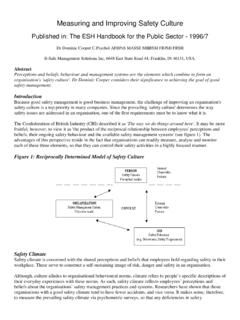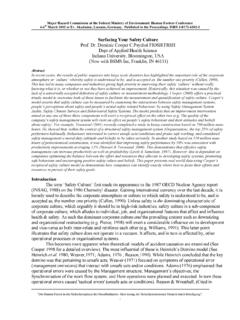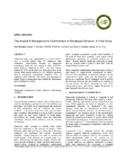Transcription of Towards a model of safety culture - Behavioral Safety
1 Safety Science 36 (2000) 111 136. Towards a model of Safety culture Cooper *. Applied Behavioural Sciences Ltd., Chartered Psychologists, 1060 Holderness Road, Hull, East Yorkshire BSMS Inc, 6648 East State HU9 Road 4AH, 44, UK Franklin, IN 46131. Abstract Organisational culture is a concept often used to describe shared corporate values that a ect and in uence members' attitudes and behaviours. Safety culture is a sub-facet of orga- nisational culture , which is thought to a ect members' attitudes and behaviour in relation to an organisation's ongoing health and Safety performance. However, the myriad of de nitions of `organisational culture ' and ` Safety culture ' that abound in both the management and Safety literature suggests that the concept of business-speci c cultures is not clear-cut.
2 Placing such ` culture ' constructs into a goal-setting paradigm appears to provide greater clarity than has hitherto been the case. Moreover, as yet there is no universally accepted model with which to formulate testable hypotheses that take into account antecedents, behaviour(s) and con- sequence(s). A reciprocal model of Safety culture drawn from Social Cognitive Theory (Ban- dura, 1986. Social Foundation of Thought and Action: A Social Cognitive Theory. Prentice Hall, Englewood Cli s, NJ.) is o ered so as to provide both a theoretical and practical framework with which to measure and analyse Safety culture . Implications for future research to establish the model 's utility and validity are addressed.
3 # 2000 Elsevier Science Ltd. All rights reserved. Keywords: Organisational culture ; Safety culture ; Goal-setting; Reciprocal determinism; Triangulation;. Safety climate; Safety behaviour; Safety management systems; Levels of measurement; Levels of analysis 1. Introduction Many industries around the world are showing an increasing interest in the con- cept of ` Safety culture ' as a means of reducing the potential for large-scale disasters, and accidents associated with routine tasks. Publicly stated aims of achieving homogeneous worldwide Safety cultures in the o shore (May, 1998), nuclear (Rosen, 1997) and shipping (Payer, 1998) industries testify to its growing impor- tance.
4 Although well intentioned, such aims also illustrate the confusion that * Tel.: +44-1482-708899. 0925-7535/00/$ - see front matter # 2000 Elsevier Science Ltd. All rights reserved. PII: S0925-7535(00)00035-7. 112 Cooper / Safety Science 36 (2000) 111 136. surrounds the concept. This confusion appears to emanate from fragmented and unsystematic empirical e orts using underspeci ed theoretical concepts (Kennedy and Kirwan, 1995), that is perhaps due to a lack of an underlying integrative framework (Flin, 1998) which can be used to guide examinations of the Safety culture construct in a wide range of contexts. 2. The concept of corporate culture In response to the recognition that its structure has limitations in providing the `glue' that holds organisations together, much management thinking over the last two decades has focused on the concept of corporate culture .
5 Some of the writings on the topic ( Peters and Waterman, 1982; Ouchi, 1981; Pascale and Athos, 1981;. Deal and Kennedy, 1982; Hofstede, 1990) have been extremely in uential among practising managers, mainly via its assumed relationship with organisational per- formance. It is generally thought that a well-developed and business-speci c culture into which managers and employees are thoroughly socialised will lead to stronger organisational commitment, more e cient performance and generally higher pro- ductivity (Deal and Kennedy, 1982; Graves, 1986; Hamden-Turner, 1990). Usually based upon a blend of visionary ideas, corporate culture appears to re ect shared behaviours, beliefs, attitudes and values regarding organisational goals, functions and procedures which are seen to characterise particular organisations (Furnham and Gunter, 1993).
6 The maintenance of the dominating corporate culture within any organisation, therefore, is supported by ongoing analyses of organisational systems, goal-directed behaviour, attitudes and performance outcomes (Fry and Killing, 1989). However, due to a general lack of information on how culture works, or how it can be shaped, changed or otherwise managed in practise (Furnham and Gunter, 1993), there is no consistent de nition of what corporate culture might be (Williams et al., 1989). The main di erence between such de nitions appear to reside in their focus on the way people think, or on the way people behave (Williams et al.)
7 , 1989), although some focus on both the way people think and behave ( Margulies and Raia, 1978; Uttal, 1983). Williams et al. (1989) take issue with the notion that organisational culture re ects shared behaviours, beliefs, attitudes and values. They argue that not all organisa- tional members respond in the same way in any given situation, although there may be a tendency for them to adopt similar styles of dress, modes of conduct, and per- ceptions of how the organisation does, or should, function. Beliefs, attitudes and values about the organisation, its function or purpose can vary from division to division, department to department, workgroup to workgroup, and from individual to individual.
8 Thus, although an organisation may possess a dominating `cultural theme', there are likely to be a number of variations in the way in which the theme is expressed throughout the organisation (Williams et al., 1989; Hamden-Turner, 1990;. Furnham and Gunter, 1993). For example, one department may put Safety before production, whereas another department may put production before Safety . In the former, risk assessments might always be conducted prior to starting every job, Cooper / Safety Science 36 (2000) 111 136 113. while in the latter, people circumvent all the Safety rules and procedures to ensure continuation of production.
9 It follows, therefore, that several di erent sub-cultures will emerge from, or form around, functional groups, hierarchical levels and orga- nisational roles, with very few behaviours, beliefs, attitudes or values being com- monly shared by the whole of the organisation's membership. In turn, these sub- cultures may either be in alignment, or at odds, with the dominating `cultural'. theme. This is not surprising given that organisations are ``dynamic, multi-faceted human systems that operate in dynamic environments in which what exactly suits at one time and one place cannot be generalised into a detailed universal truth''.
10 (Dawson, 1996, p. 162). Pidgeon (1998) argues that di ering sub-cultures actually serve a useful function, as they are a valuable resource for dealing with collective ignorance determined by systemic uncertainty because they provide a diversity of perspectives and interpretation of emerging ( Safety ) problems. 3. The concept of Safety culture The term ` Safety culture ' rst made its appearance in the 1987 OECD Nuclear Agency report (INSAG, 1988) on the 1986 Chernobyl disaster. Gaining interna- tional currency over the last decade, it is loosely used to describe the corporate atmosphere or culture in which Safety is understood to be, and is accepted as, the number one priority (Cullen, 1990).




